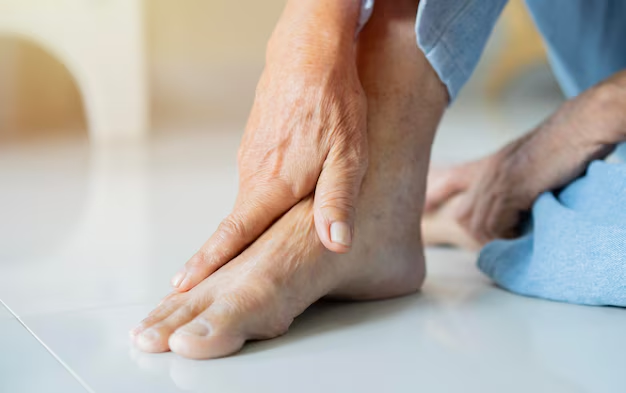Finding Comfort: Understanding and Managing Gout on Your Foot
Imagine waking up to a throbbing, fiery sensation in your big toe that makes even the weight of a bedsheet unbearable. This isn’t a bad dream; it's the reality for many people living with gout, a painful form of arthritis. Understanding how to manage and treat gout, particularly on the foot, is crucial for easing discomfort and maintaining mobility. Let's delve into the essentials of managing this condition without feeling overwhelmed by complex medical jargon.
What is Gout?
Gout is a type of arthritis characterized by sudden, severe pain, redness, and swelling, often affecting the joint at the base of the big toe. This pain results from the buildup of uric acid crystals within joints. Uric acid is a waste product normally dissolved in your blood, but when your body produces too much or excretes too little, it can crystallize and accumulate.
Symptoms of Gout on the Foot
Recognizing the signs of a gout attack can help you seek prompt relief:
- Intense joint pain: Usually in the big toe, although it can occur in any joint.
- Lingering discomfort: After acute pain subsides, some discomfort may last from a few days to a few weeks.
- Inflammation and redness: The affected joint(s) become swollen, tender, and warm.
- Limited range of motion: Over time, gout can impair joint movement.
Why the Foot?
Gout most commonly affects the foot, specifically the big toe, due to gravity and temperature factors. The lower temperature in extremities like the feet can promote uric acid crystallization. Additionally, the pressure and stress from walking and standing make these joints a prime target.
Medical and Lifestyle Management
While there's no cure, management strategies can help prevent flare-ups and reduce symptoms. Here's a well-rounded look at options:
Prescription Medications
Prescription drugs are often the go-to solution for managing gout:
- Nonsteroidal anti-inflammatory drugs (NSAIDs): These relieve pain and inflammation.
- Corticosteroids: For those who can’t take NSAIDs, these can effectively reduce inflammation.
- Colchicine: This anti-inflammatory provides relief if taken shortly after symptoms appear.
Dietary Modifications
Adjusting your diet plays a pivotal role in managing gout:
- Limit purine-rich foods: Found in red meats, some seafood, and alcoholic beverages, especially beer.
- Stay hydrated: Aim for at least 8–10 glasses of water daily to help flush out uric acid.
- Eat a balanced diet: Incorporate low-fat dairy, whole grains, and plant-based proteins.
Home Remedies and Lifestyle Changes
Incorporating lifestyle changes and home remedies can further alleviate symptoms:
- Rest the affected foot: Elevating and resting can reduce swelling.
- Cold therapy: Applying an ice pack wrapped in a cloth can numb pain and reduce inflammation.
- Weight management: Achieving a healthy weight reduces stress on affected joints.
Prevention Strategies
Preventing gout attacks can save you from a great deal of pain. Consider these practical strategies:
- Regular exercise: Engage in low-impact activities to maintain joint flexibility and weight control.
- Limit alcohol and sugary drinks: Both contribute to higher uric acid levels.
- Consistent monitoring: Regular check-ups can help manage uric acid levels effectively.
Understanding Risk Factors
Being aware of the risk factors can prepare you better:
- Genetics: Having family members with gout increases your susceptibility.
- Age and sex: It is more common in men, but women's risk increases post-menopause.
- Medical conditions: Hypertension, diabetes, and kidney disease enhance the risk.
Complementary Approaches
Exploring complementary methods might provide additional relief:
Herbal Supplements
Some people find relief with supplements such as:
- Vitamin C: May help lower uric acid levels.
- Cherries and cherry juice: Known for anti-inflammatory properties, potentially reducing uric acid.
Mindful Practices
Incorporating stress management techniques can have a beneficial impact:
- Yoga and meditation: Help manage stress and promote overall well-being.
- Acupuncture: Some find this method effective in reducing chronic pain.
When to Seek Professional Help
Even with vigilant management, gout can sometimes require more urgent medical attention. Seeking professional help is crucial if:
- Symptoms persist: If pain and swelling don’t improve.
- Frequent flare-ups: Occurring more often than before.
- Development of tophi: Lumps of uric acid crystals form under the skin.
Empowering Yourself with Knowledge
Armed with this information, you’re better equipped to face the challenges gout presents. Remember, while this guide provides an overview of managing gout, collaborating with healthcare providers is key to tailoring a plan suited specifically to your needs.
Transform pain into empowerment by understanding your condition and exploring the varied management avenues. Your journey begins with knowledge, and every step taken is a step towards relief and comfort.
Quick Guide to Managing Gout on the Foot:
- 🔍 Recognize Symptoms: Intense toe pain, swelling, and redness.
- 💧 Stay Hydrated: Aim for 8–10 glasses of water daily.
- 🥦 Dietary Adjustments: Limit purines; embrace low-fat and high-fiber foods.
- 🏃♂️ Stay Active: Engage in regular, low-impact exercises.
- ❄️ Cold Therapy: Use ice packs to reduce inflammation.
- 🧘 Mindful Practices: Incorporate yoga and stress-reducing activities.
- 📈 Regular Monitoring: Keep track of uric acid levels with routine check-ups.
